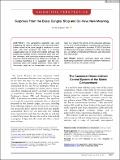Surprises From the Basal Ganglia: Stop and Go Have New Meaning
Author(s)
Graybiel, Ann M
DownloadPublished version (1.025Mb)
Publisher with Creative Commons License
Publisher with Creative Commons License
Creative Commons Attribution
Terms of use
Metadata
Show full item recordAbstract
This perspective highlights new worksuggesting the need for revision of the canonical direct–indirect model of the basal ganglia’s influence on move-ment, with fresh evidence that there is a formerlyunappreciated pair of direct and indirect pathways thatparallel the standard model’s canonical direct and indi-rect pathways, and promising evidence pointing towardimproved clinical treatments for Parkinson’s disease. Asa working hypothesis, it is suggested that the non-canonical direct and indirect pathways, which arise instriosomes, might act as homeostatic circuits that canreign in or amplify the activity of the canonical pathwaysin the face of their imbalance, including that occurring inhyperkinetic or hypokinetic disorders.
Date issued
2025-08-14Department
McGovern Institute for Brain Research at MITJournal
Movement Disorders
Publisher
Wiley
Citation
Graybiel, A.M. (2025), Surprises From the Basal Ganglia: Stop and Go Have New Meaning. Mov Disord, 40: 2077-2082.
Version: Final published version